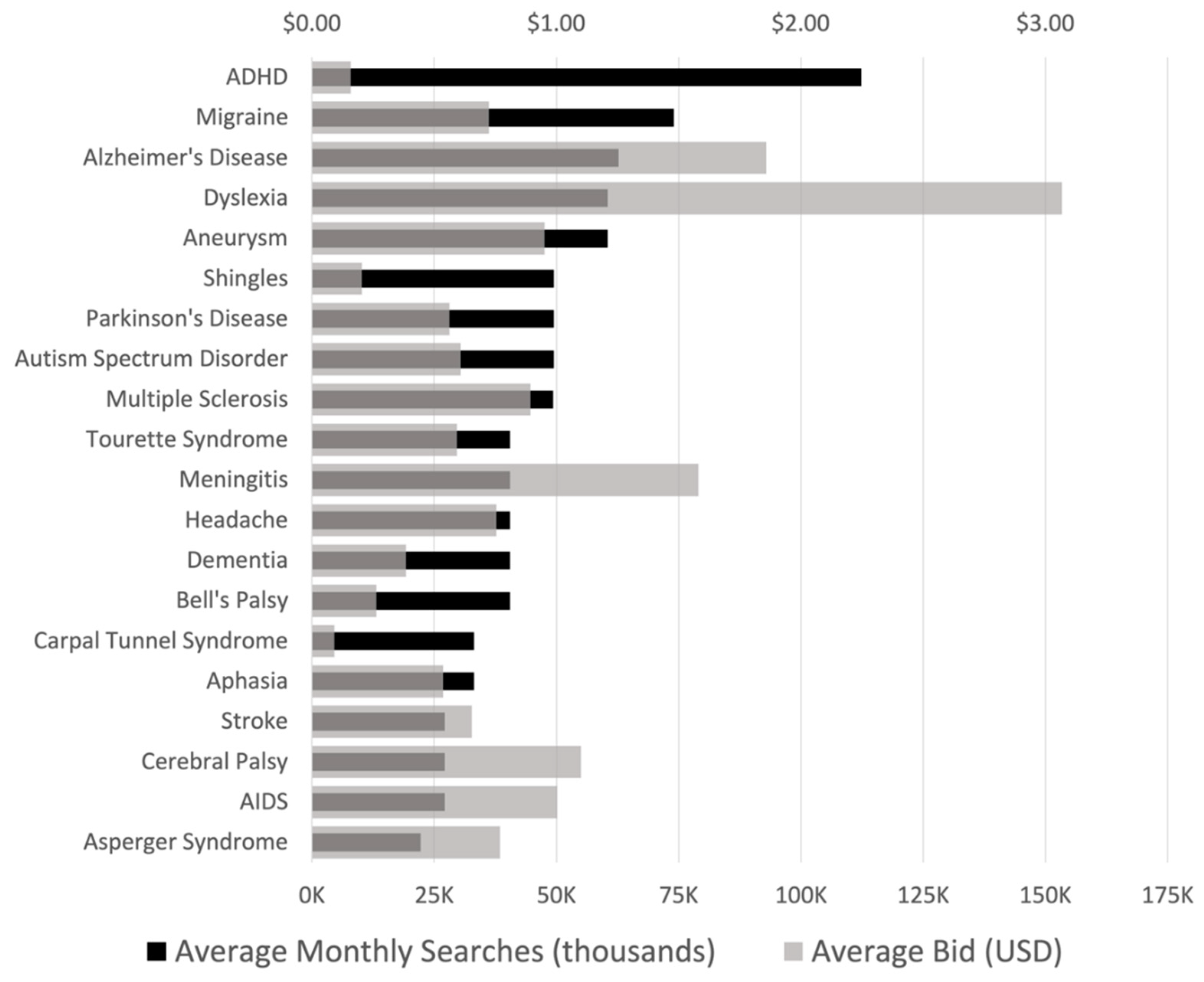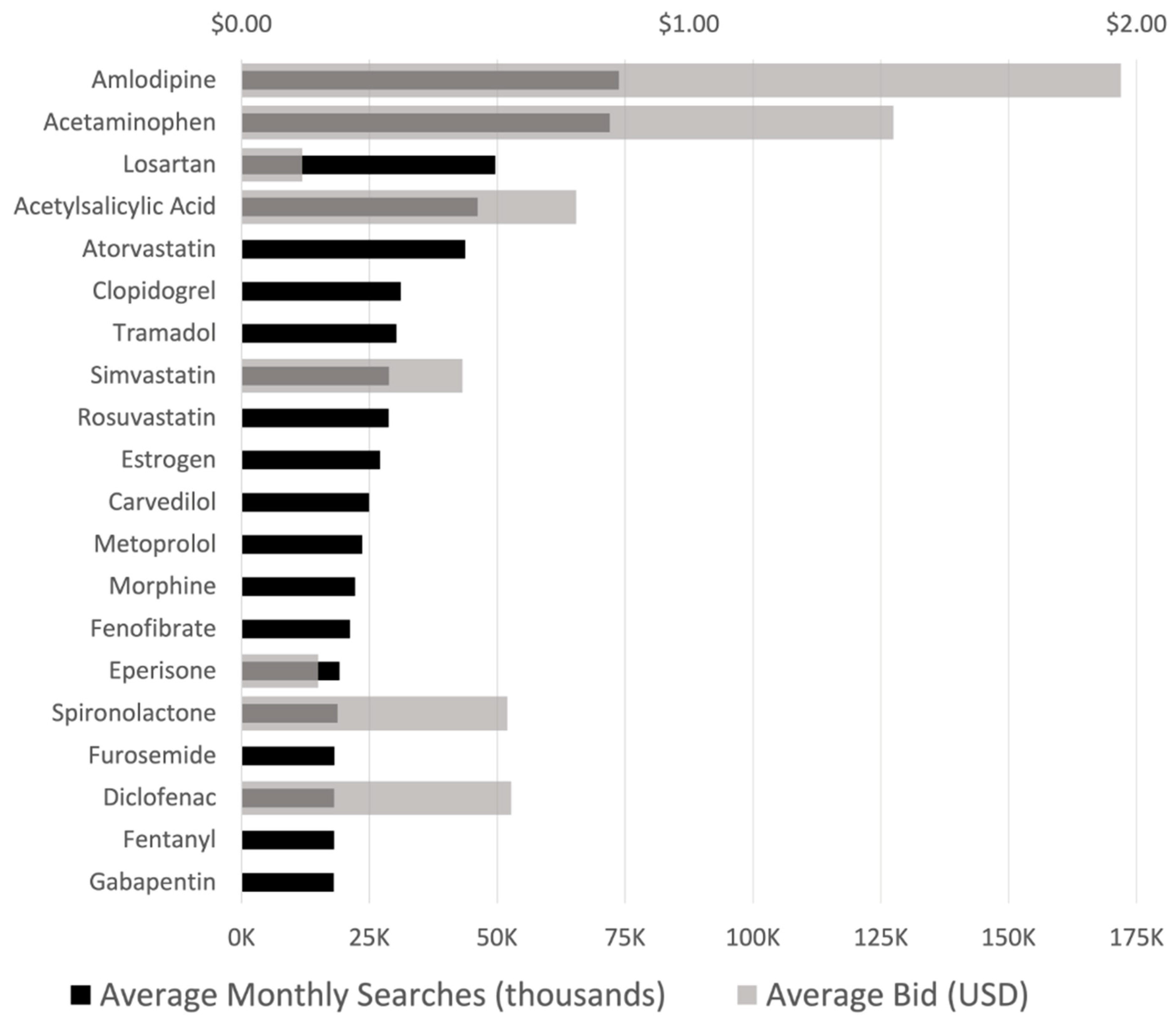Burden of Neurological Diseases in the Philippines as Revealed by Web Searches: An Infodemiological Study
Abstract
1. Introduction
2. Materials and Methods
2.1. Web Searches
2.2. Databases
2.3. Analysis
3. Results
3.1. Frequency of Neurological Diseases in Web Searches
3.2. Frequency of Central Nervous System (CNS) Drugs Searches
3.3. Analysis Based on Web Searches
4. Discussion
5. Conclusions
Author Contributions
Funding
Institutional Review Board Statement
Informed Consent Statement
Data Availability Statement
Conflicts of Interest
References
- Feigin, V.L.; Vos, T.; Nichols, E.; Owolabi, M.O.; Caroll, W.M.; Dichgans, M.; Deuschl, G.; Parmar, P.; Brainin, M.; Murray, C. The global burden of neurological disorders: Translating evidence into policy. Lancet Neurol. 2020, 19, 255–265. [Google Scholar] [CrossRef] [PubMed]
- Chang, Y.; Song, T. The burden of neurological diseases in Asia: An analysis for the global burden of disease study 2019. Stroke 2022, 53, ATMP97. [Google Scholar] [CrossRef]
- Bujnowska-Fedak, M.M.; Waligóra, J.; Mastalerz-Migas, A. The internet as a source of health information and services. Adv. Exp. Med. Biol. 2019, 1211, 1–16. [Google Scholar] [PubMed]
- Bilgin, N.; Kesgin, M.; Gücük, S.; Ak, B. Assessment of internet usage for health-related information among clients utilizing primary health care services. Niger. J. Clin. Pract. 2019, 22, 1070–1077. [Google Scholar] [CrossRef]
- Bujnowska-Fedak, M.M. Trends in the use of the Internet for health purposes in Poland. BMC Public Health 2015, 15, 194. [Google Scholar] [CrossRef]
- Mavragani, A.; Ochoa, G. Google trends in infodemiology and infoveillance: Methodology framework. JMIR Public Health Surveil. 2019, 5, e13439. [Google Scholar] [CrossRef]
- Eysenbach, G. Infodemiology: Tracking flu-related searches on the web for syndromic surveillance. AMIA Annu. Symp. Proc. 2006, 2006, 244–248. [Google Scholar]
- Alonto, A.H.D.; Jamora, R.D.G.; Leochico, C.F.D.; Espiritu, A.I. Low online search interest in teleneurology before and during COVID-19 pandemic: An infodemiological study. Neurol. Sci. 2022, 43, 2929–2934. [Google Scholar] [CrossRef]
- Moalong, K.M.C.; Jamora, R.D.G.; Roberto, K.T.; Espiritu, A.I. Patterns of Google search behavior for epilepsy and seizures in the Philippines: An infodemiological study. Epilepsy Behav. 2021, 125, 108377. [Google Scholar] [CrossRef]
- Piamonte, B.L.C.; Anlacan, V.M.M.; Jamora, R.D.G.; Espiritu, A.I. Googling Alzheimer disease: An infodemiological and ecological study. Dement. Geriatr. Cogn. Disord. Extra 2021, 11, 333–339. [Google Scholar] [CrossRef]
- Roberto, K.T.; Jamora, R.D.G.; Moalong, K.M.C.; Espiritu, A.I. Infodemiology of autoimmune encephalitis, autoimmune seizures, and autoimmune epilepsy: An analysis of online search behavior using Google Trends. Epilepsy Behav. 2022, 132, 108730. [Google Scholar] [CrossRef] [PubMed]
- Layug, E.J.; Espiritu, A.I.; Calotes-Castillo, L.V.; Jamora, R.D.G. The association of online search interest with polio cases and vaccine coverage: An infodemiological and ecological study. Eur. J. Pediatr. 2021, 180, 2435–2441. [Google Scholar] [CrossRef] [PubMed]
- Perez, J.A.L.S.; Espiritu, A.I.; Jamora, R.D.G. Google search behavior for meningitis and its vaccines: An infodemiological study. BMC Neurol. 2021, 21, 232. [Google Scholar] [CrossRef] [PubMed]
- Mondia, M.W.L.; Espiritu, A.I.; Jamora, R.D.G. Brain tumor infodemiology: Worldwide online health-seeking behavior using Google Trends and Wikipedia Pageviews. Front. Oncol. 2022, 12, 855534. [Google Scholar] [CrossRef]
- Baeza-Yates, R.; Sangal, P.M.; Villoslada, P. Burden of neurological diseases in the US revealed by web searches. PLoS ONE 2017, 12, e0178019. [Google Scholar] [CrossRef]
- Digital Marketing for Asia. The Most Popular Search Engines across APAC. 2022. Available online: https://www.digitalmarketingforasia.com/the-most-popular-search-engines-across-apac/ (accessed on 4 September 2022).
- Casanova-Gutierrez, J. Epilepsy in Philippine language and dialects. Neurol. Asia 2012, 17, 83–85. [Google Scholar]
- Schumacher, S.; Kent, N. 8 Charts on Internet Use around the World as Countries Grapple with COVID-19. 2022. Available online: https://www.pewresearch.org/fact-tank/2020/04/02/8-charts-on-internet-use-around-the-world-as-countries-grapple-with-covid-19/ (accessed on 4 September 2022).
- Yeung, A.; Ng, E.; Abi-Jaoude, E. TikTok and attention-deficit/hyperactivity disorder: A cross-sectional study of social media content quality. Can. J. Psychiatry 2022. [CrossRef]
- Paulus, T.; Bäumer, T.; Verrel, J.; Weissbach, A.; Roessner, V.; Beste, C.; Münchau, A. Pandemic tic-like behaviors following social media consumption. Mov. Disord. 2021, 36, 2932–2935. [Google Scholar] [CrossRef]
- Moalong, K.M.C.; Espiritu, A.I.; Fernandez, M.L.L.; Jamora, R.D.G. Treatment gaps and challenges in epilepsy care in the Philippines. Epilepsy Behav. 2021, 115, 107491. [Google Scholar] [CrossRef]
- Apor, A.D.A.O.; Jamora, R.D.G. Research productivity among Filipino neurologists associated with socioeconomic, healthcare, and disease burden factors: A bibliometric analysis. Int. J. Environ. Res. Public Health 2022, 19, 15630. [Google Scholar] [CrossRef]
- Department of Health. Lifestyle-Related Diseases. 2022. Available online: https://doh.gov.ph/lifestyle-related-diseases. (accessed on 3 September 2022).
- Ignacio, K.H.D.; Espiritu, A.I.; Jamora, R.D.G. The current status and challenges in multiple sclerosis management in the Philippines. Mult. Scler. Relat. Disord. 2020, 46, 102510. [Google Scholar] [CrossRef] [PubMed]
- Jamora, R.D.G.; Miyasaki, J.M. Treatment gaps in Parkinson’s disease care in the Philippines. Neurodegener. Dis. Manag. 2017, 7, 245–251. [Google Scholar] [CrossRef] [PubMed]
- Aboueid, S.; Liu, R.H.; Desta, B.N.; Chaurasia, A.; Ebrahim, S. The use of artificially intelligent self-diagnosing digital platforms by the general public: Scoping review. JMIR Med. Inform. 2019, 7, e13445. [Google Scholar] [CrossRef] [PubMed]




Publisher’s Note: MDPI stays neutral with regard to jurisdictional claims in published maps and institutional affiliations. |
© 2022 by the authors. Licensee MDPI, Basel, Switzerland. This article is an open access article distributed under the terms and conditions of the Creative Commons Attribution (CC BY) license (https://creativecommons.org/licenses/by/4.0/).
Share and Cite
Alonto, A.H.D.; Apor, A.D.A.O.; Jamora, R.D.G. Burden of Neurological Diseases in the Philippines as Revealed by Web Searches: An Infodemiological Study. Int. J. Environ. Res. Public Health 2022, 19, 16736. https://doi.org/10.3390/ijerph192416736
Alonto AHD, Apor ADAO, Jamora RDG. Burden of Neurological Diseases in the Philippines as Revealed by Web Searches: An Infodemiological Study. International Journal of Environmental Research and Public Health. 2022; 19(24):16736. https://doi.org/10.3390/ijerph192416736
Chicago/Turabian StyleAlonto, Anisah Hayaminnah D., Almira Doreen Abigail O. Apor, and Roland Dominic G. Jamora. 2022. "Burden of Neurological Diseases in the Philippines as Revealed by Web Searches: An Infodemiological Study" International Journal of Environmental Research and Public Health 19, no. 24: 16736. https://doi.org/10.3390/ijerph192416736
APA StyleAlonto, A. H. D., Apor, A. D. A. O., & Jamora, R. D. G. (2022). Burden of Neurological Diseases in the Philippines as Revealed by Web Searches: An Infodemiological Study. International Journal of Environmental Research and Public Health, 19(24), 16736. https://doi.org/10.3390/ijerph192416736







